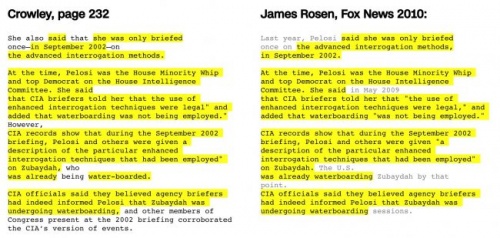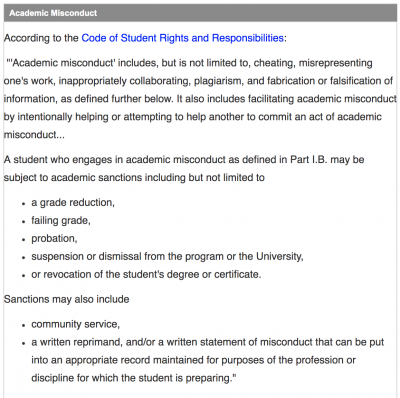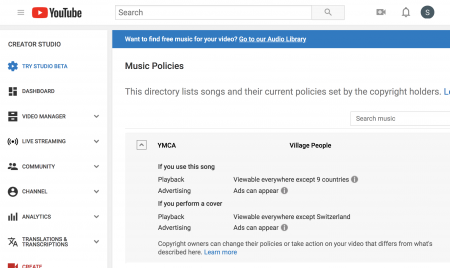Plagiarism
Plagiarism is the act of improperly incorporating existing work either without authorization or without documentation, or both.[1]. The use of another’s words, images, videos, or music without appropriate citation or acknowledgment is considered plagiarism. It is not a crime to plagiarize, but it can lead to copyright infringement, a legally punishable offense. [2] Plagiarism is often prevalent in politics and has evolved greatly over time with the advancements in technology and the internet. Academic and industrial institutions consider plagiarism a serious ethical violation that often ends in punishment deemed appropriate by said institutions. [3]
Contents
Types of Plagiarism

Plagiarism can come in many forms, whether it be purposeful or accidental. It can happen at work, at school, and more commonly today, on the Internet. Legal measures for these actions are regarded in the context and intent the work was produced. It is recommended to avoid these situations entirely or make use of proper usage and citation techniques.[5]
- Written Work: representing someone else’s work as your own, copying another’s thoughts and words without appropriate citation, forgetting to use quotation marks, giving false information about the source, using the same sentence structure but altering words.[5]
- Music: using another’s copyrighted music in your own work, playing a cover using copyrighted music, creating music that borrows heavily from copyrighted work. [5]
- Images/Videos: using videos and images in one’s own work without proper citation, recreating images or videos in the same likeliness of another’s work, altering another’s videos or images without citation.[5]
- Self-plagiarism: reusing one’s own words or ideas that were previously published in another context without proper citation.[6]
Plagiarism and Politics
While plagiarism comes in many different forms, one area that has been the focus of plagiarism lately has been politics. Plagiarism in politics is often easily identified due to the fact that politicians are constantly under scrutiny of the public. Everything that politicians say or write will be analyzed by news groups and reporters and any plagiarism in those works will be identified. Even works from the politician's past will be scrutinized as it is extremely important that everything that they say and write is their own work or properly cited. In American politics we have seen candidates plagiarise speeches, books, and reports. Plagiarism also exists in other countries politics including Russia and Hungary.
Ghostwriting in American History
Ghostwriting, defined as writing for or in the name of another person[7], has been commonly practiced throughout U.S. history. In the early 1800s, ghostwriting was originally seen as a form of forgery. By the 1900s, however, its perception changed to one of collaboration and authorship — the work of a ghostwriter was no longer commonly accepted as plagiarized writing.[8] Speeches and statements of early American politicians who acted without ghostwriters can be analyzed in an effort to reconstruct their thought processes. This form of analysis is not able to be replicated on politicians who employed ghostwriters because what the politician presented as their own work actually represented the words of one or more members on a ghostwriting team. While ghostwriting was originally seen as plagiarism, after the 1900s it became so normalized that most of the public stopped questioning it. One of the most common objections was that ghost-written speeches could depict politicians inaccurately and inauthentically. This view shifted, though, to consider ghostwriting as a social benefit in which more jobs were created for stenographers, archivists, mailmen, etc.[8]
Melania Trump Plagiarism Controversy
The current First Lady of the United States of America Melania Trump gave a speech during the Republican National Convention on July 18, 2016 that incorporated themes of inclusivity, honesty, and hard work.[9] Even though her speech immediately resonated with the audience at the convention, later skepticisms raised arguments that Melania’s speech bore strong resemblance to the speech given by previous First Lady Michelle Obama back in 2003.
According to one investigation done by news channel MSNBC, one passage from Melania Trump’s speech was 84% similar to the parallel passage in Michelle Obama’s speech.[10] From a report generated by an internet-based plagiarism detection service, a piece of work that is above 25% similar to a source material is deemed highly probable of plagiarism.[11] Sources stated that Melania received help from Trump campaign's speechwriter while drafting the speech. Despite the controversies, Melania still received support from her husband - current U.S. President Donald Trump - and no one from Trump's presidential campaign team was fired or received disciplinary action in the aftermath.[12]
John Walsh Plagiarism Controversy
Montana Senator John Walsh was exposed for plagiarizing his graduate school papers at the United States Army War College. [13] It was found that Senator Walsh had copied large portions of his final paper about the case for democracy from multiple documents without properly attributing them or attributing them incorrectly. [14] Some of these documents included a Harvard Paper and a paper from the Carnegie Endowment for National Peace. There were entire pages which were plagiarized from these documents including Senator Walsh's entire conclusion.[14]
Following these events, Senator Walsh withdrew from his reelection campaign.[13]
Evolution of Plagiarism
The first instance of ‘literary theft’ stems back to 40 AD. The Roman poet Martial used the Latin word plagiarus, literally meaning ‘kidnapper,’ in one of his poems to describe someone who was stealing his work. It wasn’t until 1601, during the Age of Enlightenment, that playwright Ben Johnson introduced a derivative of the word, plagiary, in English. [15] During this era, original works increased in value also increasing the occurrence and acknowledgement of plagiarism.
The first copyright law in existence was the Statute of Anne in England in 1710, recognizing copyright as an author’s right. Author’s could register their work to be protected by the government for a limited period of time. [16] The United States followed suit in 1790, passing their own copyright law modeled off the Statute of Anne, protecting maps, charts, and books for a fourteen year period. Overtime, many amendments were made to the act, broadening the range of works that were protected and for how long. [17] The Copyright Act of 1976, still employed today, provides copyright protection to all published and unpublished works so long as they are in tangible form[18]. These acts influenced academic and industrial institutions to build their own standards for recognizing and addressing acts of plagiarism overtime.
The introduction of the World Wide Web has drastically changed the way information is received and perceived. With these changes, a large gray area has formed over the use of this information and the modes in which it is transferred. In an effort to govern online infringement, Congress passed the Digital Millennium Copyright Act (DMCA) in 1998.[19] This act “makes it illegal to circumvent technological measures used to prevent unauthorized access to or copying of copyrighted works, particularly books, movies, videos, video games, and computer programs.” [20] Filing a DMCA takedown notice can help remove infringing material online, but there are currently no regulations regarding the sharing of online content as policies are still evolving in response to new technologies.[21][22]
Social Media
Social media is a gray area for copyright because the point of these platforms is to share your creations with others. On platforms like Twitter, copyright is not such an issue because the origin of any tweet is specified in a re-tweet. However, on platforms where content creation has more dimensions than just text, such as Instagram and Youtube, copyright issues arise. Where the line is drawn between an original creator and a re-creator, for example, is hard to determine. Many social media platforms have created their own, fairly strict copyright policies in order to avoid legal issues.
YouTube has its own music policy that lists many songs and the consequences of using them in a video. For example, some countries block these videos all together, and many songs cause ads to appear in videos in order to generate income to pay the owners of these songs.
Instagram also has its own copyright policies, but it also has a "fair use" policy, which recognizes that strict copyright law is not appropriate in all situations as it stifles creativity and creation on the platform. While it doesn't eliminate all copyright problems, as people have been kicked off of live Instagram stories for playing copyrighted music in the background, it allows for "small pieces" of other peoples' work to be reused.[23] After all, sharing ideas and spreading content is the intention of social media platforms in the first place.
Plagiarism in Computer Science
The sudden overwhelming interest in computer science courses has coincided with the undesirable side effect of high-tech collegiate plagiarism. Across the country, students have been caught plagiarizing computer code from fellow classmates or stealing it from the internet.[24]
The statistics from elite universities across the country indicate a staggering number of allegations of academic honor code violations. At the University of California, Berkeley, approximately 100 of about 700 students in one computer science class had violated the course policy on copying code. At Brown University, out of the 49 allegations of academic code violations in 2016, more than half of them involved cheating in computer science classes. At Stanford University, the alma mater of the founders of Google, Hewlett Packard, Snap Inc., and countless other technological wonders, as many as 20 percent of the students in a single computer science class were flagged for potential cheating in 2015. At Harvard University, where the famed Computer Science 50 (CS50) is practically its own brand, the class distinguished itself in a more questionable way in the Fall of 2016. According to the Harvard Crimson, more than 60 students were sent to the university’s honor council for allegations of academic dishonesty, which includes plagiarism and violations of the honor code.[24]
“There’s a lot of discussion about it, both inside a department as well as across the field,” said Randy H. Katz, a professor in the department of electrical engineering and computer science (EECS) at the University of California, Berkeley, one of the nation’s leading computer science schools. Computer science professors across the country are now delivering stern warnings at the beginning of each course and deploy software to flag cases of plagiarism. However, professors also acknowledge that to some students drawn to computer science classes, coding does not come easily. The coursework can be very time-consuming, more so than other classes. Websites such as GitHub may have answers to assignments students are struggling with, as students that have previously taken the course often leave their repositories public instead of making them private. As Jackson Wagner, a former Harvard CS50 student who was not accused of plagiarism, said, “You’ve got kids who were struggling with spending a third of their time on their problem sets with the option to copy from the internet. That’s the reason why people cheat.” Even though coding can be a foreign language to most people, the principles of plagiarism that apply to papers written in English also apply to coding assignments. Sometimes it may be acceptable for lines of code to be identical, if the code is performing a routine or trivial task or one that cannot be done in a different way. However, other times it is a red flag.[24]
Legal Implementations
Plagiarism can be considered theft or even fraud in some contexts, but it is not a criminal or civil offense. [25] Legal consequence can occur if it infringes on an author’s intellectual property rights, which are outlined by the United States Constitution - “to promote the Progress of Science and useful Arts, by securing for limited Times to Authors and Inventors the exclusive Right to their respective Writings and Discoveries."[26] Plagiarism and copyright infringement are not the same, despite both referring to a similar act. “Copyright infringement occurs when a copyrighted work is reproduced, distributed, performed, publicly displayed, or made into a derivative work without the permission of the copyright owner.” [27] Plagiarism also differs from copyright infringements in the fact that copyright violations go against the rights of the copyright holder, when the copyrighted material is used without consent. Plagiarism is more of an ethical construct, concerned with giving appropriate credit where it is rightfully earned.
Consequences of Plagiarism
Academic Misconduct Consequences

The Code of Student Rights and Responsibilities states that plagiarism fits under the guidelines for academic misconduct.[28] This means that students who commit plagiarism are subject to punishment which could include a grade reduction, a failing grade, probation, suspension, or the revoking of degree of diploma.[28] Each academic institution has the right to decide the degree of punishment based on the amount of plagiarism that was committed by the student.
A Matter of Ethics
Plagiarism in academic and corporate institutions is not a matter that is taken lightly and most often results in penalty, suspension, or expulsion. It is considered theft and strips the rightful author of any accolade for their work. Not only does plagiarized work gives a false representation of the knowledge and abilities of the plagiarizer, [29], it also has the potential to misrepresent expressions of the original author, resulting a level of harm similar to slander which injures a person's reputation.[30] Garnering achievements and promotions for ideas that aren’t your own could be a risk to others in educational or corporate environments, thus the reason for the serious consequence. The Internet has introduced a large gray area causing confusion about what is ethical when accessing content online.[31] The increasing volume of unauthorized content so easily available has decreased the level of regard for copyright and intellectual property. The lack of tangibility increases the ease of reproducibility, making information hard to safeguard and keep to one’s self.[32] The accessibility of information via a computer screen makes it easier for users to subside feelings of empathy for the actions they take.[21] Streaming, sharing, and downloading has become a Digital Age norm, where users don’t think twice about the owner of the content.[21] There is little to no repercussion or regulation of the sharing of online content at this point in time as policies are still evolving in response to new technologies.[21] This does not change the ethical violation that this act causes as it still involves using content created by someone else.
Sources
- ↑ Snapper, John., 2008. "The Matter of Plagiarism: What, Why, and If", The Handbook of Information and Computer Ethics, pg. 533
- ↑ Wikipedia: Copyright Infringement. (2002). https://en.wikipedia.org/wiki/Copyright_infringement
- ↑ Imran, N. (2010). Electronic media, creativity and plagiarism. ACM SIGCAS Computers and Society, 40(4), pp.25-44.
- ↑ Kaczynski, A. (2017). Trump national security pick Monica Crowley plagiarized multiple sources in 2012 book. CNN Money. https://money.cnn.com/interactive/news/kfile-trump-monica-crowley-plagiarized-multiple-sources-2012-book/index.html
- ↑ 5.0 5.1 5.2 5.3 What is Plagiarism? (2017). Turnitin, LLC. https://www.plagiarism.org/article/what-is-plagiarism
- ↑ Mudrak, B. (2019). Self-Plagiarism: How to Define it and Why You Should Avoid It. American Journal Experts. https://www.aje.com/arc/self-plagiarism-how-to-define-it-and-why-to-avoid-it/
- ↑ "ghostwriting." Merriam-Webster.com. https://www.merriam-webster.com/dictionary/ghostwriting (10 April, 2019)
- ↑ 8.0 8.1 May, E., "Ghost Writing and History", The American Scholar, p. 459-465
- ↑ 2016, July 19. US election: Melania Trump 'plagiarised' Michelle Obama. BBC News. https://www.bbc.com/news/election-us-2016-36832095
- ↑ MSNBC. (2016, July 19). Lawrence: Melania Trump's Passage 'Pure Plagiarism' of Michelle Obama. Retrieved from: https://www.youtube.com/watch?v=a1xxm2aaEew
- ↑ (2013, September). Interpreting Turnitin Originality Reports. Retrieved from: https://eat.scm.tees.ac.uk/bb8content/resources/recipes/interpretTurnitin.pdf
- ↑ Krieg, Gregory., 2016, July 19. No one to be fired after Melania Trump speech plagiarism episode. CNN News. https://www.cnn.com/2016/07/19/politics/melania-trump-michelle-obama-speech/index.html
- ↑ 13.0 13.1 Fawxy, F(2016). From speeches to Ph.D.'s: Politicians called out for copying. CNN. https://www.cnn.com/2016/07/19/politics/politicians-plagiarism/index.html
- ↑ 14.0 14.1 Martin, Jonathon. How Senator John Walsh Plagiarized a Final Paper. New York Times, 23 July 2014. Retrieved 10 April 2019.
- ↑ Bailey, J. (2011). The World's First Plagiarism Case. Plagiarism Today. https://www.plagiarismtoday.com/2011/10/04/the-world%E2%80%99s-first-plagiarism-case/
- ↑ Statute of Anne. (n.d.). Encyclopædia Britannica. https://www.britannica.com/topic/Statute-of-Anne
- ↑ Congress Passes the First Copyright Act. (n.d). U.S. Copyright Office. https://www.copyright.gov/timeline/timeline_18th_century.html
- ↑ Congress Passes the Current Copyright Act. (n.d.). U.S. Copyright Office. https://www.copyright.gov/timeline/timeline_1950-1997.html
- ↑ Wikipedia: Digital Millennium Copyright Act. (2002). https://en.wikipedia.org/wiki/Copyright_infringement
- ↑ Congress Passes the Digital Millennium Copyright Act. (n.d.). U.S. Copyright Office. https://www.copyright.gov/timeline/timeline_1998-2012.html
- ↑ 21.0 21.1 21.2 21.3 Ethics and Intellectual Property. MediaSmarts, 2014. http://mediasmarts.ca/digital-media-literacy/digital-issues/online-ethics/ethics-intellectual-property.
- ↑ What is a DMCA Takedown? (2019). Digital Millennium Copyright Act Services Ltd. https://www.dmca.com/faq/What-is-a-DMCA-Takedown
- ↑ [1]
- ↑ 24.0 24.1 24.2 Bidgood, J., & Jeremy. (2017, May 29). As Computer Coding Classes Swell, So Does Cheating. Retrieved from https://www.nytimes.com/2017/05/29/us/computer-science-cheating.html
- ↑ Morrow, S. (n.d.). Plagiarism: What is it, Exactly? LegalZoom.com. https://www.legalzoom.com/articles/plagiarism-what-is-it-exactly
- ↑ U.S. Constitution. Article I, Section 8, Clause 8. (n.d.). http://constitutionus.com/
- ↑ Definitions: What is Copyright Infringement? (n.d). U.S. Copyright Office. https://www.copyright.gov/help/faq/faq-definitions.html
- ↑ 28.0 28.1 28.2 Plagiarism: Consequences of plagiarism. (n.d.). Code of Academic Misconduct. University of Utah http://campusguides.lib.utah.edu/c.php?g=237735&p=1585547
- ↑ What Makes Plagiarism a Serious Offense? (2016). MLA Handbook, 8th ed. https://style.mla.org/plagiarism-and-academic-dishonesty/
- ↑ Snapper, John., 2008. "The Matter of Plagiarism: What, Why, and If", The Handbook of Information and Computer Ethics, pg. 542
- ↑ Steeves, Valerie. Young Canadians in a Wired World, Phase III: Experts or Amateurs? Gauging Young Canadians’ Digital Literacy Skills. MediaSmarts, 2014. http://mediasmarts.ca/ycww/experts-or-amateurs-gauging-young-canadians-digital-literacy-skills.
- ↑ Mason, Richard. (1986). Four Ethical Issues of the Information Age. MIS Quarterly. Vol. 10. No.1. https://www.researchgate.net/publication/242705009_Four_Ethical_Issues_of_the_Information_Age
